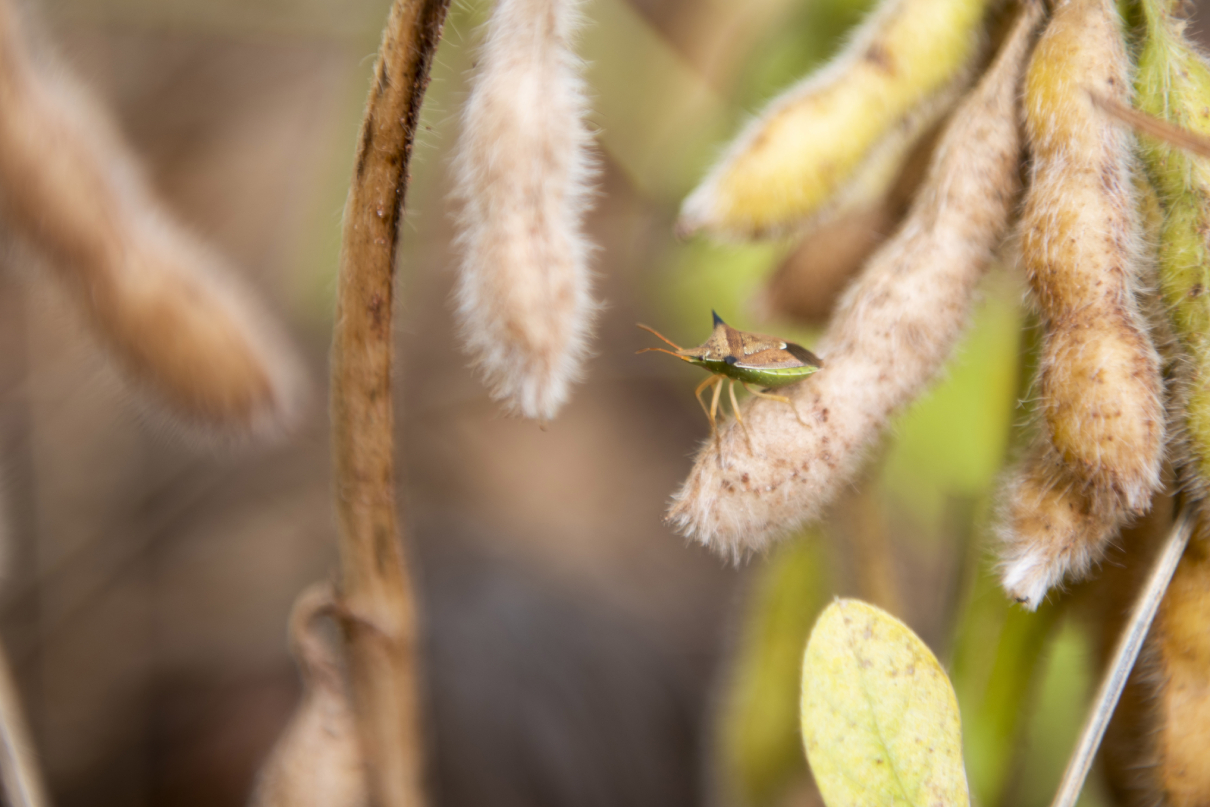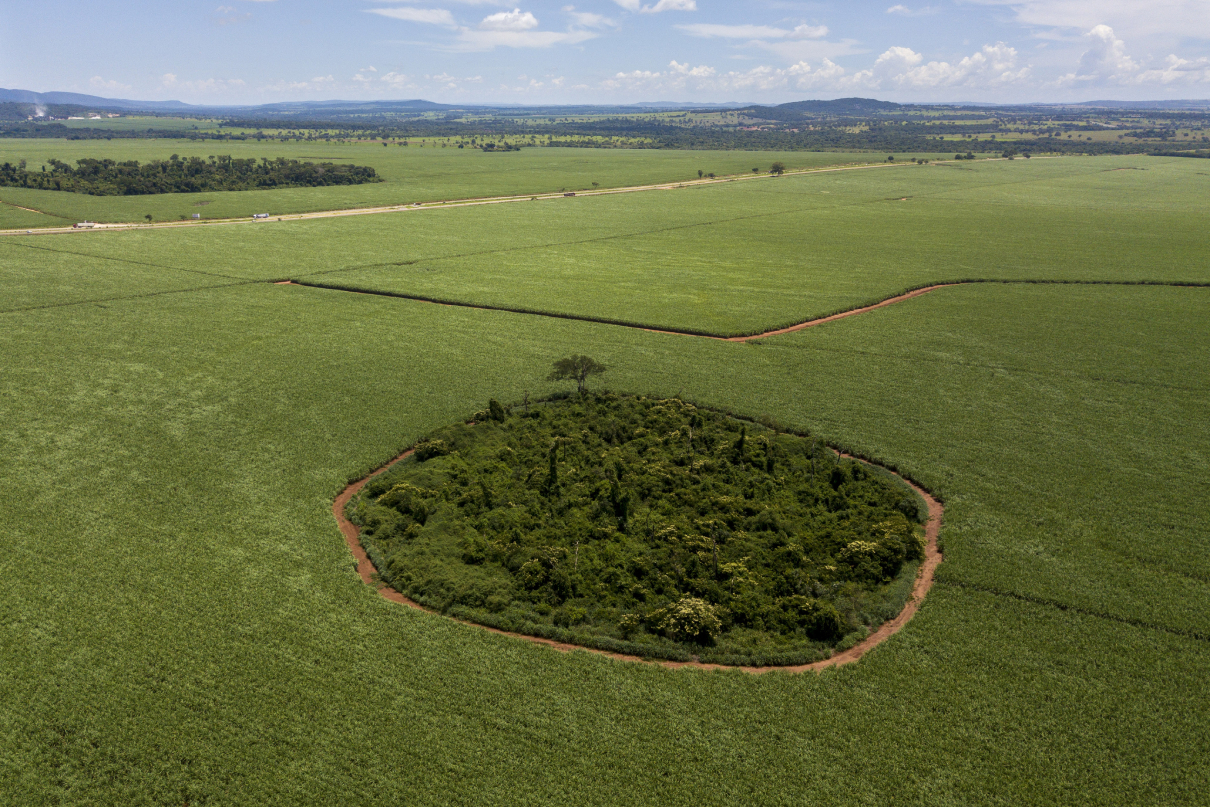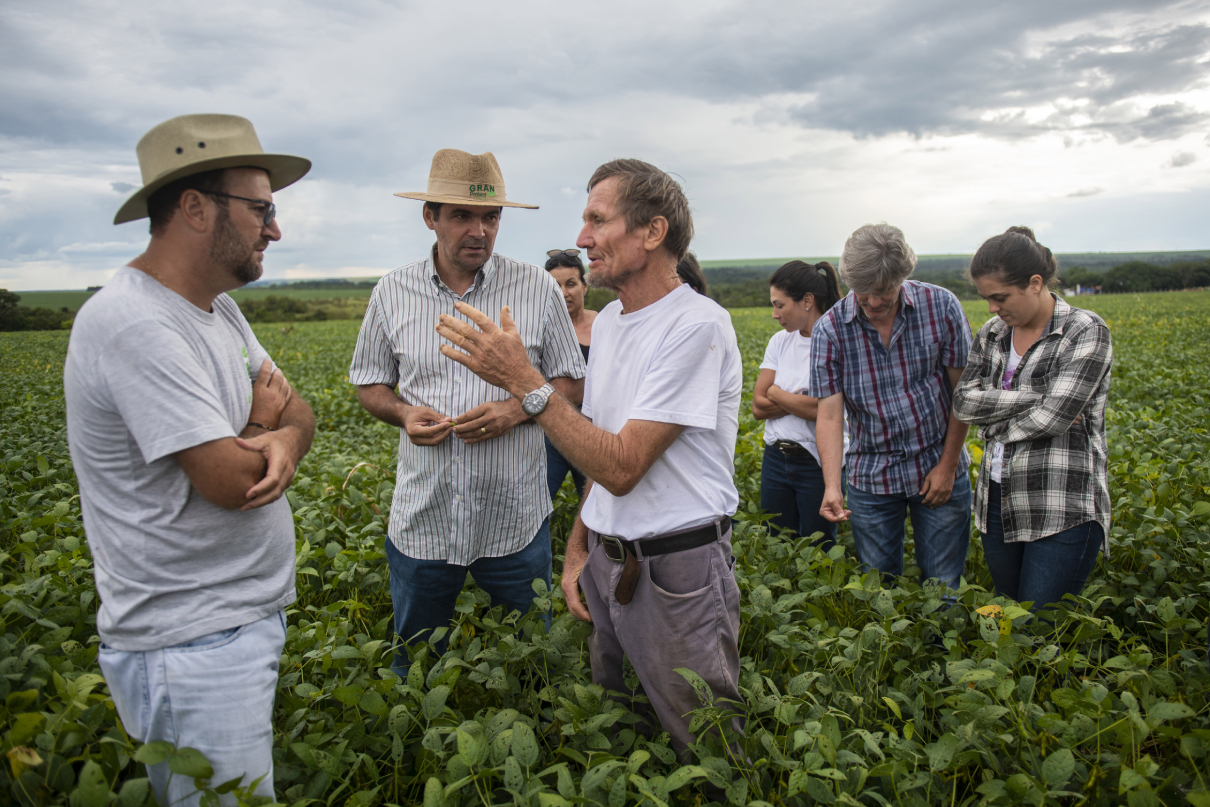- Brazilian-based Swiss agronomist and cocoa farmer Ernst Götsch has created a model of organic farming that he says can replace the Green Revolution that was driven by advances in agrichemistry.
- His syntropic farming system imitates nature and is based on successful agroforestry methods.
- It is climate-friendly, ecologically sustainable and above all cost-efficient, attracting a growing number of soy farmers in Brazil interested in implementing it.
MINEIROS/GANDÚ, Brazil — Behind the wheel of his black suburban van, Paulo Borges has to squint to focus on the SUV motorcade in front of him, vanishing in a red cloud of dust. Borges, a landowner, is following other farmers to a workshop on the road near Mineiros in the midwest of Brazil, the grain-growing heartland of the country. Brazil is the world’s biggest producer of soybeans, and half of it is grown here in the savanna-like region of the country known as the Cerrado, according to the national statistics institute, or IBGE.
Green soy fields stretch to the horizon, separated by straight, reddish-brown dirt tracks. Every few miles, a few tall red cedars and ironwood trees, replete with parrots, are a reminder that the Cerrado was once the transition forest to the Amazon.
But for the most part, the sun burns down on the flat, nearly shadowless land.
Industrial agriculture has been practiced here for three decades. Companies such as Bayer-Monsanto, Novartis and Pioneer deliver what’s known in the industry as technological packages: genetically modified seeds bundled with specially adapted pesticides and fertilizers. Cooked up in laboratories, the packages are tailor-made to withstand the environmental risks — climate variations and all sort of pests — unique to this area. That’s the way Borges and the men and women in the caravan have been cultivating their land for decades.

Modern slavery
“We spray chemicals at least 11 times per harvest cycle, on average every 10 days,” says Borges, a black-haired, pensive man in a checked shirt, jeans and straw hat. The 49-year-old owns 10,000 hectares. He harvests twice a year, soy and corn in rotation, and sells to commodities traders like Cargill and other multinational brokers.
The sales are transacted over the internet, and the soy is exported for use in animal feed, mainly to Asia and Europe. It’s made Borges a rich man; he lives in a luxury compound and can send his children to the best universities. Twenty years ago, the soil was fertile, the harvest abundant, glysophate-resistant crops were not an issue. The yield was up to 3,600 kilograms (8,000 pounds) per hectare, Borges says.
Today, the model is reaching its limits: glysophate resistance and soil infertility have reduced productivity by up to 30%. Borges says he needs to use more glysophate but still sees lower yields. The all-round packages still work for the very big players with the best soil and control over the whole production chain. That means they have their own silos, grain banks and transport fleets to ship the soy. Smaller producers end up in debt. “It’s modern slavery,” Borges says.
The three dozen landowners in Borges’s motorcade traveling through the soy fields are looking for ways out of the trap. Their destination is the Invernadinho soy farm near Mineiros, where Swiss agronomist Ernst Götsch is holding a workshop on syntropical agriculture. Götsch is 72 years old, skinny, with a goatee. He’s a farmer’s son from Lake Constance and is old enough to remember the hard years after WWII, obstinate enough to resist the trends that have come and gone in agriculture and science.
During his post-war youth, Götsch observed the farmers and their ways of working the fertile land around Lake Constance. “There were many hedges between the fields. Fruit orchards were usually at the edge of the forest,” he says. But those traditions were lost and considered obsolete during the Green Revolution of the 1950s, driven by advances in agrichemistry.
Yet Götsch stuck to the old practices even during his studies at the Swiss Federal Institute of Technology (ETH) in Zurich. In the 1980s, as his peers focused on genetic engineering in the lab, he was in the greenhouses experimenting with mixed cultures. Götsch says he made interesting discoveries during this time. “Growth in mixed cultures increased on average by 30%.”
Through mixed cultures, he learned of the role of microorganisms in the soil, then focused on how ecosystems affect productivity. Götsch systematized his findings and labeled the result syntropic agriculture: a self-sufficient agroforestry system in which different plants interact with one another and, over time, form increasingly complex ecosystems and more fertile soils. Intelligent design and management replace pesticides and fertilizers.
After several years of research in Zurich, Götsch accepted an assignment at a coffee plantation in Costa Rica to test his ideas on a large scale in other climatic zones; he also spent some time in Africa.
Unlike modern agriculture, in the syntropic model the forest plays a key role.
Diversity reigns in Götsch’s agroforest, in contrast to the monocrop uniformity of the Green Revolution. That’s the case regardless of whether the main production is focused on cocoa, soy, wheat, bananas or citrus fruits. Humans still play a role in the system. “We are the giraffe,” Götsch says; farmers regularly have to trim the rows of trees that flank the crops. “Trimming stimulates the growth of the plants, creates biomass which is added to the soil as a fertilizer and makes the light come in which stimulates the photosynthesis and therefore absorbs more carbon dioxide,” he says.

The Swiss who brought back the rain
Götsch practices his method on his own farm in Gandú, in the state of Bahia.
He won the 120-hectare (300-acre) farm 30 years ago in a bet.
“This was scrubby grassland,” he says as he climbs a tree in his rubber boots and dirty trousers and cuts off branches with his chainsaw. The soil was impoverished by deforestation and years of cattle ranching, and most of the water sources had dried up. The Brazilian Department of Agriculture had certified the land as “unsuitable for cocoa.”
The bean was Bahia’s flagship product in the 1980s, and land that wasn’t suitable for cocoa was considered worthless. Götsch says a wealthy landowner offered him a wager: he would buy the land for Götsch, and if the system he touted worked, he could pay back the landowner with the harvest. Götsch started out planting trees.
He refused to use artificial fertilizers and pesticides. He let most of the land grow naturally, and on 12 hectares (30 acres) he planted bananas and cocoa, cutting back the surrounding trees regularly. Today, he harvests an average 920 kgs (2,000 lb) of cocoa beans per hectare, more than three times the average across Brazil of 300 kg (660 lb) per hectare. And because he doesn’t spend money on fertilizers and pesticides, unlike the farmers around him, Götsch enjoys higher profits.
His wife, Cimara, says the neighbors laughed at him initially. In the town of Gandú, he was known as the “crazy gringo.” But after five years, a small forest had emerged and the first springs had returned to the area. Götsch was able to pay back his loan with cocoa and bananas.

The plants grew so vigorously that even the rampant fungal diseases that attacked the plantations around him could not harm his property. Then a drought hit the region. But not on Götsch’s farm. The dense vegetation of the 120 hectares locally created a lot of evaporation and the rain continued to fall. His success as a “rainmaker” finally earned Götsch the respect of his neighbors. They started to imitate him. Today, the forested area in the surroundings spans 1,000 hectares (2,500 acres). “When you fly over my finca now, you can’t see it anymore, because it is covered by clouds all year round,” Götsch says proudly.
He hardly pauses a minute while talking. Götsch first attracted the attention of alternative groups such as Florestas da Futura, ECHO, ASPTA, Cooperafloresta, and small farmers. Then, Pedro Diniz, the son of a prominent Brazilian businessman, hired him to transform his father’s conventionally managed farm into a syntropical model. Fazenda da Toca in the state of São Paulo, combined production of tropical fruit, chicken and eggs, wood and vegetables, with ecological education programs for the kids of the surrounding schools. The project ended due to personal problems, but made Götsch famous as the “Agroforestry Pope.”
He now travels the world, from Portugal to China, as a consultant and gives workshops. But there’s still work to be done at home. “February and July are the best month to cut back the branches,” he says while crushing jackfruit branches with his machete to drape them under a cocoa tree.
When asked how productive his farm is, he answers contentedly: “Just like the conventional ones of my neighbors, but with fewer costs.” That’s a very strong argument for soy farmers such as Borges, listening with attention despite the heat in Mineiros as Götsch holds court with the aid of graphs and plenty of practical anecdotes from a lifetime dedicated to agriculture.

Imitating nature instead of fighting against it
“The decline of advanced civilizations has always been initiated by an exhaustion of natural resources, beginning with the Romans and continuing with the Mayans,” Götsch says at the start of his workshop at the Invernadinho farm. “And it always had to do with men struggling against the forest.” “Do human beings consider the forest as something dark and unpredictable and therefore fight against it?”, asks Götsch the audience. Everybody listens carefully, probably for the first time confronted with this sort of question.
Götsch is convinced that human mindset plays dirty tricks to homo sapiens, a creature of the Savannah. He reminds that with the exception of a few Indigenous groups, human beings always preferred to settle on wide grasslands, where enemies could be discovered from far. But Götsch says the challenge this time around can be overcome. “Nature has so far always recovered from human inflicted setbacks.” But he adds we should do better by cooperating and imitating nature instead of fighting against it, and so the Brazilian farmers who came to Mineiros to listen to him think the same.
Syntropic agriculture works without chemical fertilizers or pesticides or artificial irrigation, and is 100% organic. Because of the low costs, a single hectare (2.5 acres) can easily feed a family, and 4 hectares (10 acres) can lead to prosperity, Götsch has calculated — provided that the products are processed at the farm and there are no, or very few, intermediate traders for transport, marketing and sales. On his cocoa farm, everything is a family business.

His wife and their two daughters produce and sell the house brand, Götsch: cocoa crumbs and dark chocolate tablets are produced in the kitchen and sold in simple paper bags in Gandú, at the workshops, and on a regional fair trade circuit. In 2016, he sold a harvest to one of the finest chocolatiers in the world, the Italian Amadei – for four times more than the average market price at that time.
But Götsch says he wants to get out of the ecological niche. “My desire is that my way of farming will become a global model,” he says. That’s why he’s engaging with the soy farmers. Two years ago, he started working with the group from Mineiros. What began with 40 participants has now grown to thousands, networked via WhatsApp, the mobile messaging platform.
The euphoria of the pioneering spirit can be felt at the workshop. “I am looking for new methods of cultivating, the conventional way is not sustainable from an environmental point of view, but also financially,” says Rogerio Vian, who owns 1,000 hectares and cultivates corn and soy. “I have problems with weeds and still need a lot of glyphosate which kills everything. So I hope for a solution with syntropic agriculture.”
Fellow farmer Vania Toledo, who is hosting Götsch’s workshop at her Invernadinho farm, says she’s interested not only in a more productive farm, but in a less superficial way of living. “Syntropical agriculture is a way of creating abundance, enjoying nature in its plentitude,” she says. “It means being responsible and leaving a better world to our grandchildren.”
But the challenge of practicing syntropic agriculture at a large scale is huge, as can be seen at Toledo´s farm: not all crop associations work together; different crops such as beans, bananas, soy and citrus fruits are harvested at different times of the year, which calls for more surveillance and labor. There are no one-size-fits-all solutions in the mold of the technological packages that come with genetically modified crops. Each farm needs its own tailor-made combination.
“We lack consultants and suitable machines,” says seminar participant Marco Janssen. Because these do not yet exist, Götsch designs his own machines. He has already found a few tinkerers near Gandú able to bring his sketches to life. But during a test at Invernadinho, the large lawnmower-grass pile breaks down after only a few minutes. “That’s normal, we have acknowledged the error and have to try again,” Götsch tells the skeptical Janssen. Another problem is the lack of skilled consultants and workers.
Götsch has trained several agronomists in his method, but nowhere near enough to cover the demand. Paid video tutorials on the internet show only the basics, but do not help with every issue. And quick remedies are imperative for the big farmers, for whom a bad harvest can run up millions of dollars in losses and lead to bankruptcy.
But Borges says he’s undeterred. “My family refused some years ago to live on our farm any longer. Because it smelled of chemistry, not nature,” he says. Borges has already curbed the use of chemical fertilizers and pesticides on his land and replaced them with compost and plant homeopathy. He says he hopes syntropic farming will make glyphosate, the key herbicide in soybean cultivation, superfluous. Then grasses and weeds, until now the soy farmers’ most stubborn enemies, will become allies.
“In 10 years’ time, I want to be completely free of poison,” Borges says. Then, he says, perhaps his grandchildren will enjoy farming again.
Banner image: There are few species like Rheas (Rhea americana) who can survive in a landscape completely modified by conventional large-scale agriculture. Photo by Florian Kopp.
